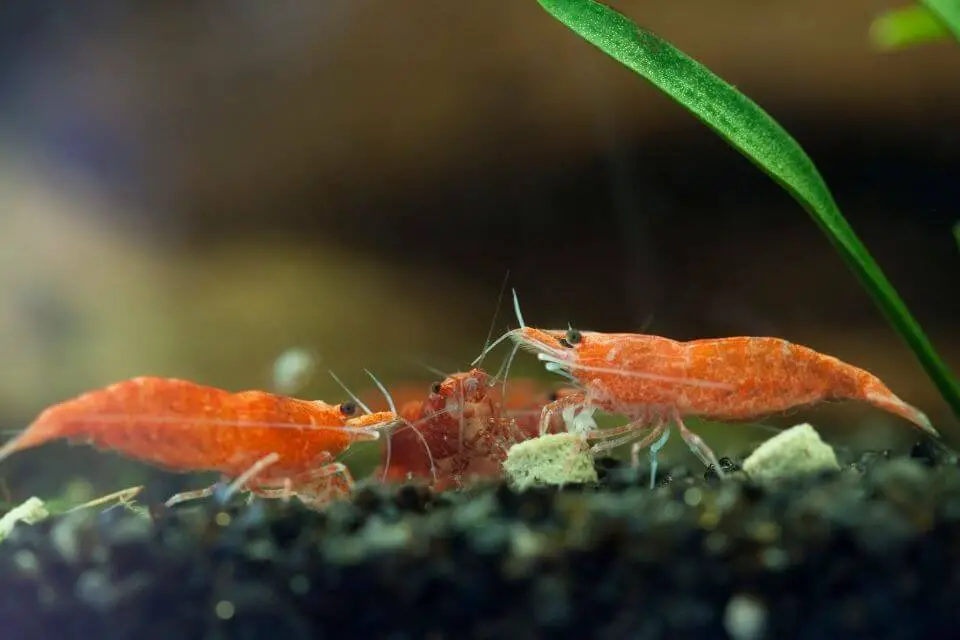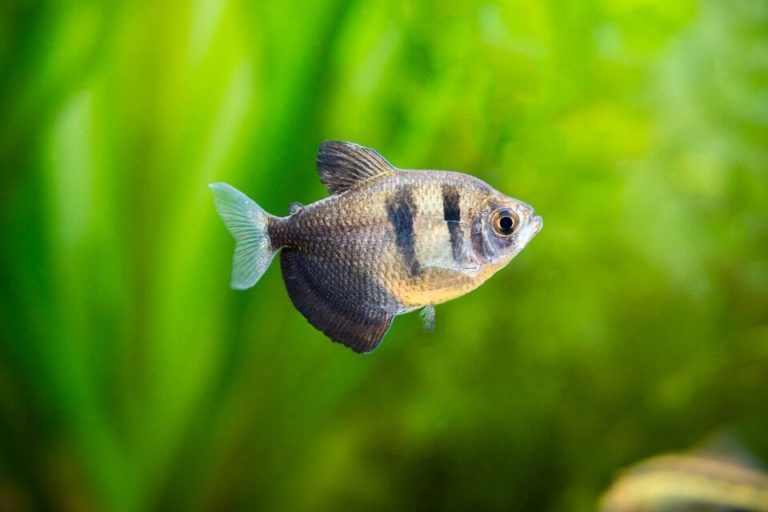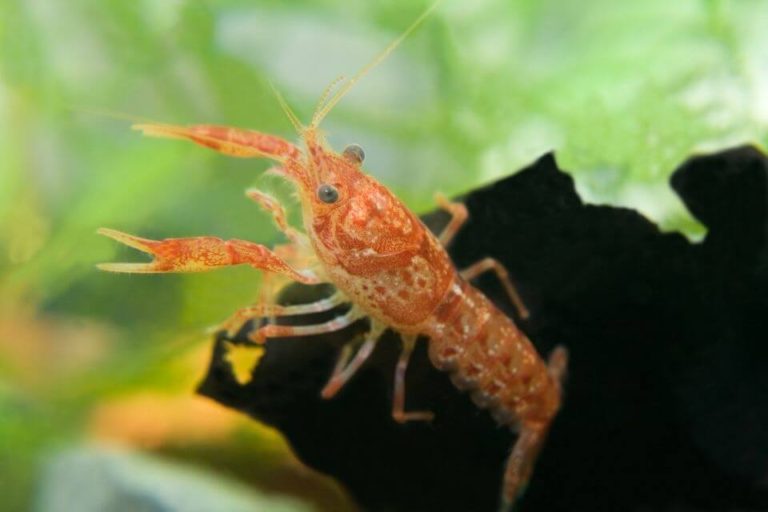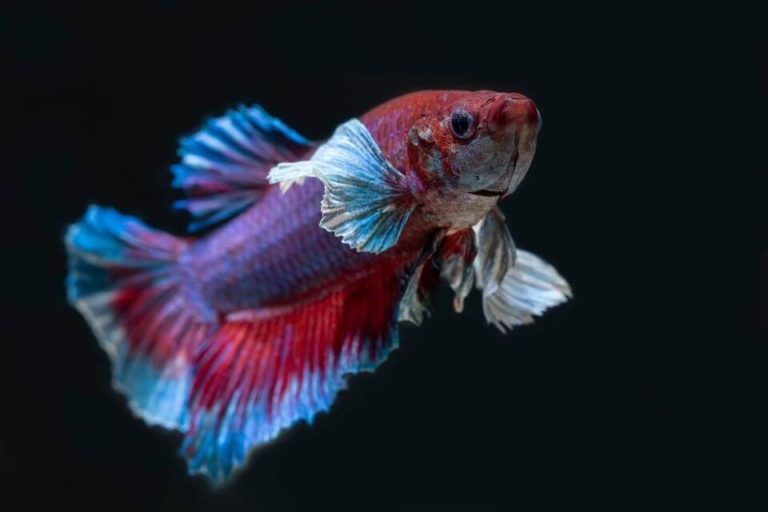Rosy Barb Care 101: Best Tank Mates, Tank Size, Diet, Breeding and More
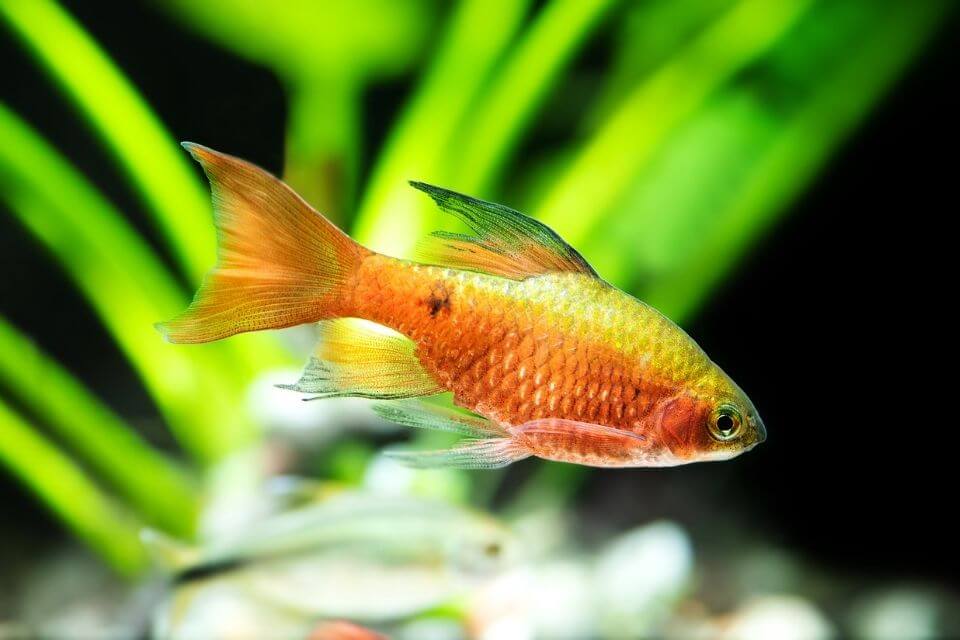
Rosy Barb fish is one of the most beautiful tropical freshwater fish species with a high contrast of yellow and pink colors. It is fascinating to have an aquarium community full of a variety of peaceful tropical fish species.
Their soft, attractive, and colorful nature attracts many Aquarists to own and care for them. At the same time, caring for them would be easy and straightforward.
Interestingly, these species prefer being in large groups, which means their happiness will increase when they are kept in the same tank with other mates.
Even though they are easy to keep and maintain, Rosy Barbs also demand critical things to further their longer stay and continue leading happy lives.
This Rosy Barb care article will cover a wide area regarding the care of Rosy Barb and everything else you need to know.
Species Overview
The Rosy Barb or Pethia conchonius is a freshwater fish that belongs to the Cyprinidae family. They are sometimes referred to as Red Barb, and due to hardiness and simplicity, most beginner Aquarists prefer to rear them.
They are very peaceful, unique, and colorful. it has black markings on the fins and sides, with males exhibiting brighter reddish colors while females show olive and golden hues.
Even though they are peaceful, some breeding arrangements can occasion their aggressive nature. They belong to the class Actinopterygii, genus Pethia, and species Conchonius.
Further, they belong to the Barbinae subfamily and order Cypriniformes. Unlike males, female Rosy Barb does not have any black color in their fins. They are widespread in southern Asian countries and are very magnificent fish species.
Interestingly, they have little forked tails, and slender and torpedo-shaped bodies which distinguish them from the rest. Because of their calmness, they are effortless to keep among other tank mates.
They are known for their color-changing behavior, especially during the breeding period. Aquarists use color-changing nature to understand that the time for breeding is nearing.
Rosy Barb Size
Rosy Barb size can grow up to a maximum of 6 inches in the wild with the average size around 4 to 5 inches in a captivity environment. They are medium size fish species that can fit in a smaller size.
Sometimes if fed well and subjected to excellent aquarium conditions, the Rosy Barb size can increase over time. The secret of their growth lies in how best you can keep them under your optimum care.
Rosy Barb Lifespan
In the wild, a Rosy Barb lifespan can reach 5 years maximum. However, if well taken care of, they can live more than the expected years.
The owner needs to take full responsibility for ensuring that the aquarium has all the necessary qualities to enhance its lifespan. In addition, the mode of feeding, the quality of water in the aquarium, and the avoidance of stress can extend the fish’s lifespan.
Like any other pet, the more you take care of it, the more likely it will live. Even though the Rosy Barbs are hardy, they can experience negative reactions towards poor water quality and inadequate care.
Once you subject them to poor water conditions, they will likely suffer from diseases, shortening their lives. It would help to avoid relying on their natural hardiness and handle them like your favorite pets.
Behavior & Temperament
They are non-aggressive fish species and show peaceful behavior. Sometimes when introduced to new environments, they exhibit shyness; however, they adapt quickly and gain confidence over time.
When they are around a large group to socialize with, they often shy off. They are never a fighting species type; however, they usually show aggressiveness when it comes to fin-nipping.
They have the bad behavior of chasing fishes with flowing tails. However, they don’t easily destroy their tails since they are great swimmers.
Luckily enough, when the rosy barbs are in shoals, they forget their fin-nipping habit to focus on socialization. Their shoaling character makes them become stressed when they live on their own.
When in large groups, they become more active and love to swim around in the middle level of the tank. Further minimizing the fin-nipping habit would require that you avoid tank mates with long fins and flowing tails.
Rosy Barb Appearance & Colors
These species have gained popularity due to their colorful and attractive nature. If you want to experience their beauty, look at a shoal, and you will probably appreciate their attractiveness.
Rosy barb fish have a reddish-pinkish coloration throughout their bodies. Their color becomes more intense; however, when stressed or sick, they tend to fade. They have toothless jaws and are also stomach-less.
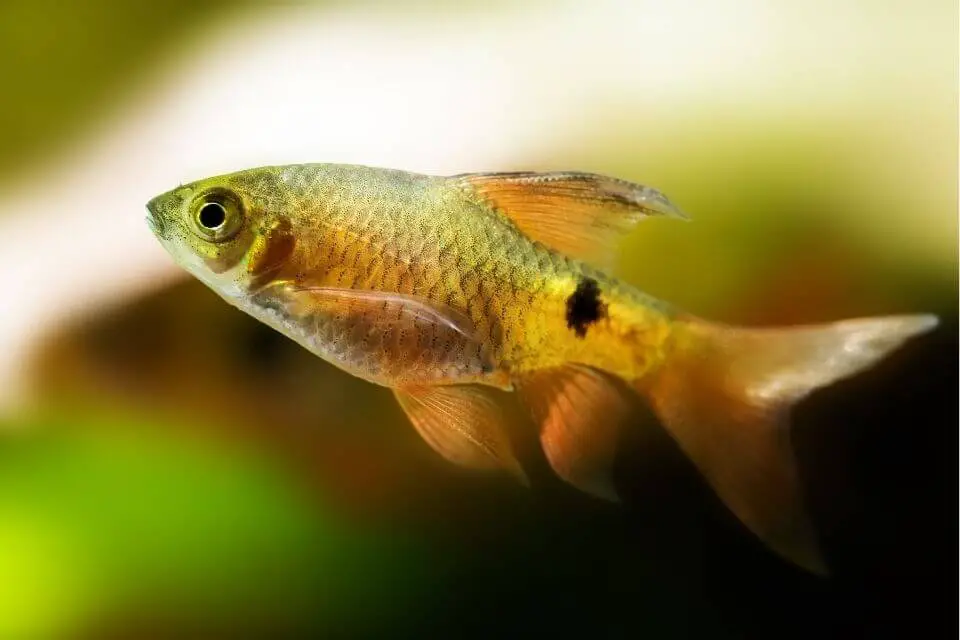
Their appearance and color can better be appreciated by looking at different types of Rosy Barb fish such as:
– Common Rosy Barb:
These common Rosy Barbs exhibit a reddish and pinkish coloration throughout their bodies while the female appears with bright yellow or gold colors. They grow between 3 to 5 inches and they know to be hard fish.
– Long Fin Rosy Barb:
They are attractive, with long flowing fins enhanced with a red coloration. They command attention, and their hardy appearance gives them a stunning look. They grow up to 6 inches (up to 13 cm).
– Neon Rosy Barb:
It is a captive-bred color developed from the Rosy Barb. It has one dorsal fin with a torpedo-shaped body. They reach a size between 3 to 5 inches long and also lack an adipose fin.
Although male Neon Rosy Bards exhibit a more red appearance, they have a coppery pink or silvery coloration body. They also have black spots in front of the caudal peduncle and some black margins on the dorsal and anal fins.
The male coloration increases to a deep rosy purplish or reddish when spawning.
Rosy Barb Care
The most significant aspect of caring for fish is keeping their aquarium clean. Dirty tanks aid in the spread of diseases. Caring involves regularly changing the water in the tank to prevent the building up and thriving of polluting agents such as fungi.
If you notice any signs of illness, embrace regular water changes. Aside from water changes, wiping the tank’s bottom is vital to prevent the excessive growth of unnecessary algae.
Diseases are dangerous to fish because they weaken their immune system. It is equally important to feed your fish a good diet to heighten their immune system and lead healthy lives.
The newbies often mistake between overfeeding and quality feeding. Overfeeding is risky because it can lead to bloating of the fish.
– Rosy Barb Tank Size
The minimum Rosy Barb tank size requirement is 20 gallons for the small group of 4 fish. Every shoal added to the group needs at least 5 gallons of water.
More space is essential due to their swimming and socializing nature of them. If you plan to keep them with a few other same-size tank mates a 30 gallons tank is recommended.
Lack of enough space will deprive them of happiness hence leading a stressful life. Equally, too much space for nothing is irrelevant. It is good to balance between adequate and small tank sizes.
– Rosy Barb Tank Setup
Rosy barbs don’t spend much of their time at the base of the tank.
- Even though the substrate is not crucial in the Rosy barb’s tank because they don’t spend much of their time at the bottom of the tank, it is safest and essential to use aquarium sand or fine-grained gravel.
- Water Filtration: A powerful filter is needed to create a strong current in the tank. Sometimes if you aren’t sure about the water movement in the tank, you may try directing your energy to the water or air pump because they are more sensitive to the oxygen content in the water.
- Use both dark and bright decorations in the tank to emulate the natural habitat. Dark decorations such as aquarium rocks and driftwood work best to provide hiding surfaces, while bright decorations compliment the bright colors of the rosy barbs.
- Lighting should be versatile since they have different reactions to different lights. Scatter the light from the surface and install snags to make the aquarium look more natural, like the subtropical lakes.
– Water Conditions and Parameters
In the wild, Rosy Barbs live in the lakes and subtropical fast-flowing streams. Their natural habitat has a water hardness of about 4 to 10 dKH and water acidity levels between 6 to 7.5 pH. While setting up an aquarium, you should emulate the same.
The water temperature should range from 64 to 80 degrees Fahrenheit (17 to 26 °C). The water conditions and the parameters should be maintained at all costs to ensure the healthy living of the rosy barbs.
If you are living outside tropical countries you may have to control the water temperate by using an aquarium water heater to stabilize the temperature levels.
Testing water pH levels regularly will help you to improve the health of your fish. In this case, you must have a good aquarium water testing kit handy.
– Suitable Aquarium Plants
The Rosy Barbs love nibbling at plants with large leaves, such as Java Fern. When you set their habitat it is essential to use plants like Hornwort, Giant Anubis, Dwarf Sags, and Water Wisteria.
Common Diseases and Prevention
Like other pets, fish also get sick. Before you commence any form of medication, you must observe to find out the disease and its cause.
The most common conditions affecting Rosy Barbs include parasitic, viral, bacterial, fungal, external arthropod parasite infections, and trues worm parasite diseases.
When you begin noticing white spots on your fish, be careful because those are red alerts of the disease’s symptoms.
The possible causes of fish infections could:
- Sudden changes in water temperatures.
- Introduction of new fish that could be carrying protozoa
- Introduction of new plants
- Lack of regular water changes
The best prevention remedies include regular cleaning of the aquariums, frequent water changes, adjusting your fish’s diet to improve the immune system, and setting up a quarantine tank to separate the infected fish from the rest.
Food and Feeding
Rosy Barbs thrive well on an omnivorous diet. For a healthy balanced diet, offer them both plant-based and meat-based food. For meat-based foods, feed them with:
For a special meal, give them meat snacks with soft-boiled Zucchini or Peas and Algae.
They have a crazy appetite for food, and overfeeding them is inevitable. It is, therefore, crucial to check how often you feed them to avoid being overweight. Overfeeding can also cause constipation and digestion issues.
Rosy Barb Male and Female Difference
It is often challenging to differentiate males from females when rosy barbs are young. Although, as they get older, differences begin showing up, with rosy male barbs showing redder and slender bodies.
The rosy female barbs remain smaller but plumper. Females have yellow, gold, or olive coloration, whereas rosy male barbs are brighter, reddish, or reddish-purple.
Female rosy barbs have round and broader abdomens. During spawning, the rosy male barbs become bright red, with orange dorsal, and have black spots on top.
In contrast, females show dim bronze coloring with almost colorless fins. Rosy barb females become fat during the spawning period.
Breeding Rosy Barb Fish
They are egg-laying fish species and are easy to breed, provided you don’t leave the eggs with the parents. You can hatch them artificially.
The following steps need to be underlie when breeding Rosy Barb fish.
- Breeding Tank: Once they reach sexual maturity, rosy barbs should be put in separate tanks of about 20 to 30 gallons and be paired. The breeding tank must be 1 to 3 degrees warmer to enhance their breeding.
- Before breeding, you should feed them well to prepare them for spawning.
- The breeding tank should not have a lot of water; it should only have a few plants to act as hiding spots as they breed.
- For you to achieve the color target, pick breeding pairs that have excellent color markings.
- When you see the rosy female barb being vibrant and playful, know that they are ready to breed.
- Spawning usually happens in the morning.
- Females will always lay their eggs in the hiding sites, and scatter them everywhere or on the spawning site.
- Ensure to remove the eggs from the surface for artificial hatching. –To safeguard the eggs from being tampered with by rosy adult barbs, try placing a spawning rope of net at the base of the tank.
- Hatching eggs: Female Rosy Barbs lay several hundreds of eggs that hatch in about one and a quarter days. It is essential to treat water using methylene blue to prevent any alterations, such as fungi, from growing on the eggs.
- When the eggs hatch, the Rosy Barb fries are usually in the larval stage. The Rosy Barb fries feed on the yolk sac of the eggs.
Rosy Barb Tank Mates
If kept alone, rosy bards will do poorly. It is essential to keep them in a group of at least five and keep observing their behavior. Generally, they are an amazing community that can get along with the following mates:
- German Blue Ram
- Zebra Danios
- Opaline Gouramis
- Swordtails
- Rope fish
- Congo Tetras
- Paradise fish
- Tiger Barbs
- Cherry Barbs
- Roseline Shark (Danison Barb)
In America, the rosy barbs are used as dither fish in the tanks to assist the shying cichlids in getting out of their hiding places. Fish compatibility is vital when raising them among a community of other fish in the same tank.
Before keeping different types of fish in the same tank, ensure to check the aspect of aggressiveness because it can lead to injuries, infections, and loss of life.
Ensure you pick the right mates for the rosy barbs to avoid troubles in the tank.
Origin and Distribution
They originate from northern India, particularly in the states of Assam and West Bengal. Rosy barbs are freshwater fish species that are also common in southern Asian countries.
They are widely distributed in Singapore, Colombia, Mexico, Australia, Rico, and Puerto. They live in flowing freshwater bodies such as streams, ponds, and lakes. They enjoy living in subtropical climates.
Rosy Barbs are very social and active. For many centuries now, Red barbs have been part of the pet trade, and that’s why feral communities have been established in non-natives places.
Rosy Barbs enjoy company, and if their school is large enough, they do not bother other aquariums. Pethia conchonius also love cooler parts and enjoy living in areas rich in fresh air.
Frequently Asked Questions
Can Rosy Barb Live Alone?
Yes, Rosy Barbs can live alone, but they enjoy being in a group. While around other non-aggressive mates like them, they spend more time socializing, playing, and swimming.
When keeping them in a group ensure you have at least 4 to 5 together to make them happy. When the school is large enough, they do not bother about other mates.
When taken good care of, rosy barbs are the most comfortable and admiring pets to have around.
Are Rosy Barbs Aggressive?
Rosy Barbs are very peaceful and avoid being aggressive. Sometimes when kept in a tank without groups or with slower-moving waters and large fish with fins or flowing tails.
You will notice their fin-nipping habit because they love playing with larger fins and tails. They love staying with fish that are peaceful because they spend most of their time socializing as they enjoy cooler temperatures.
Do Rosy Barbs Eat Snails?
It depends. Some are snails’ assassins, and you may see them plucking snails off the glass to eat them. Since they are omnivorous and enjoy meaty snacks, eating snails isn’t surprising for the rosy barbs.
How Big Do Rosy Barbs Get?
Rosy Barbs grow up to 6 inches; however, when fed properly in the aquarium, their weight increases too fast due to their nature of eating.
Why Has My Rosy Barb Lost Its Color?
Various reasons can occasion color changes in Rosy Barbs. The prominent reasons could either be illness or due to stress. In some cases, the diet and changes in water temperatures can lead to color changes.
How Often Should You Feed Rosy Barbs?
You can either feed your rosy barb twice or once a day. If you opt to feed them twice, ensure to provide them with the food they can feed in three minutes.
Whereas if you opt for once, give them an amount of food they can feed in five minutes. Avoid overfeeding them to reduce the chances of constipation and being overweight.
Can Rosy Barbs Live in A Pond?
Yes, Rosy Barb fish can live in a pond; however, providing shelter and some aquarium plants need to be placed. Equally, in the ponds, a small air or water pump is ideal for increasing oxygen levels since they become happier when water moves with a lot of oxygen.
More importantly, you have to keep them in tropical water conditions if you reside in a cold-weather country. This can be achieved by using an aquarium water heater that helps to keep the water temperature constant.
How Much Does a Rosy Barb Fish Cost?
Rosy Barbs are one the popular fish species, they are not expensive fish species. With an estimated budget of $20 to $30 in the USA aquarium market.
The prices depend on the country that you reside in, you may find them at cheap prices than the above range.
Final Thoughts
Unlike most Barbs, Rosy Barbs are known to be peaceful, attractive, and hardy. They enjoy large communities; hence, it is essential to pick friendly tank mates. As omnivorous, their feeding habits are easy to monitor.
To enhance their coloration, you should feed your Rosy Barbs with a healthy- balanced diet. If you want to keep Rosy Barbs alone, you should at least keep five of them to avoid pairing.
To reduce their fin-nipping habit, avoid keeping them keeping with long-finned fish species. Breeding them requires conditions that we discuss in the breeding section.
After reading this Rosy Barb Care guide, you will know what to expect when caring them for in the long run.


